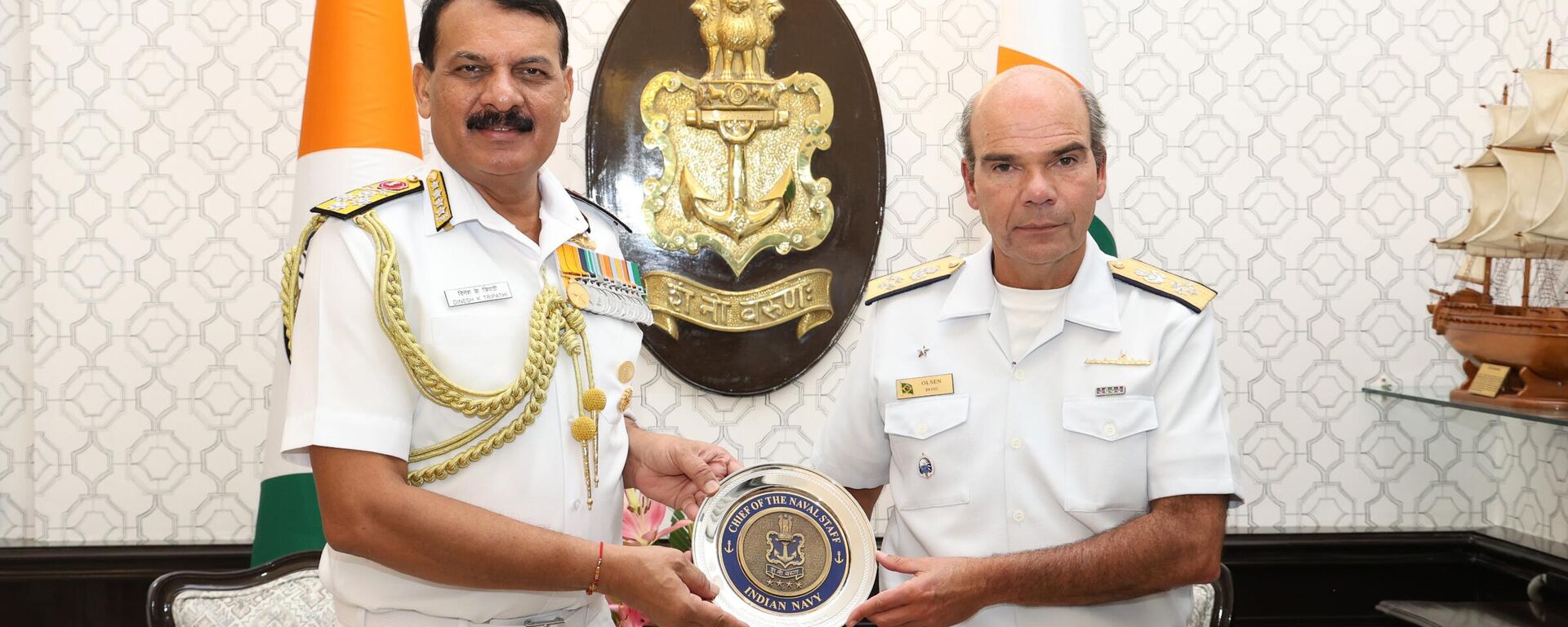https://sputniknews.in/20240821/indian-militarys-viksit-bharat-goals-roadmap-challenges-and-way-forward-8042306.html
Indian Military's Viksit Bharat Goals: Roadmap, Challenges and Way Forward
Indian Military's Viksit Bharat Goals: Roadmap, Challenges and Way Forward
Sputnik India
The Indian Army's senior leadership, including Chief of Army Staff General Upendra Dwivedi discussed a roadmap for Viksit Bharat 2047 vis-a-vis military affairs on Monday. Sputnik India examines the roadmap, challenges of the realisation, and the way forward.
2024-08-21T20:43+0530
2024-08-21T20:43+0530
2024-08-21T20:43+0530
sputnik opinion
india
indian space research organisation (isro)
indian army
military equipment
military cooperation
military spending
ministry of defence (mod)
defense sector
defense export
https://cdn1.img.sputniknews.in/img/07e7/07/10/3028514_0:0:3329:1873_1920x0_80_0_0_8bf21163a29eea5e346be8d7a3d827c2.jpg
The Indian Army (IA) envisages transforming itself into a modern, agile, adaptive, technology-enabled ready force, capable of deterring and winning wars in a multi-domain environment, across the full spectrum of operations to protect the country's national interest in synergy with the other services as per its vision for Vikshit Bharat 2047, military experts have said.Following Vikshit Bharat – Prime Minister Narendra Modi's goal to make India a developed nation by the 100th anniversary of its Independance, – the Indian Army organised a brainstorming session called "ShauryaSampravah 1.0", a first-of-its-kind initiative by the Army Chief with a select group of 18 distinguished veterans.Coinciding with the two-day session, chaired by General Upendra Dwivedi, COAS, and attended by GoCs-in-C (general officer commanding-in-chief) of the seven commands. Chief of Defence Staff General Anil Chauhan also interacted with senior veteran officers to harness their "rich experience and insights" in shaping the future of the IA and contributing to the nation's growth.The veterans were updated on transformation and all initiatives by the IA to be ready and relevant to deter and defeat future adversaries.The Viksit Bharat mission specifies "to make India a significant participant in defining world order and amongst the top countries where people want to live" while its strategic guidance rests on the pillars of Atmanirbharta (self-reliant), safe and settled borders, modernisation and indianisation of security forces, proactive shaping of global commons and nation-building in the spirit of "India First", Lt. Gen (Retd) Ashok Bhim Shivane told Sputnik India on Wednesday.Thus 2023-2032 has been earmarked as the "Decade of Transformation" and 2024-25 as "Years of Technology Absorption", Shivane added.He reckoned that despite the challenges for the military, IA has already foreseen most.However, such issues as the escalating external and internal threats, the defence budget envelope, the challenges of Atmanirbharta in the industry, indigenous disruptive technology, leadership challenges and long procurement cycles, are still concerning India's forces, the expert pointed out.Meanwhile, Shivane highlighted, the IA has fully aligned its roadmap and integrated it with the national goals and emerging security paradigms to be prepared for all operational contingencies and it plans to build the required deterrence capabilities to safeguard the nation by:On the other hand, this grand plan seeks to upgrade India's military strength by 2047 with a focus on modernisation, self-sufficiency, and improved readiness in such areas as cyber and space, defence analyst Girish Linganna noted in a conversation with Sputbnik India. The masterplan, according the expert, can be categorised into eight major planks:1. Upgrades & Tech Advancements: the need to boost combat and logistics units by embracing advanced technologies, such as AI, robotics and autonomous systems, which aim to make military operations more effective and efficient.2. Unified Efforts Across Services: better coordination among the army, navy and air force to tackle future challenges in a coordinated manner. This means developing joint strategies, running drills as a team and setting up unified command structures for smoother operations. 3. A Mighty Push for Self-Reliance: encouraging the use of homegrown equipment and weapons by closely working with local firms to create and manufacture cutting-edge military gear in India.4. Bolstering Defence Capabilities: beefing up mechanized forces, artillery, airpower and more by getting new tanks, artillery, helicopters and arms' systems to enhance combat capabilities.5. Improved Infrastructure/Support: Building top-notch facilities and improving logistics and ammo setups is crucial. This involves constructing new bases, upgrading existing ones and refining supply chain management for better preparedness.6. Streamlined Command structures: revamping command structures for better efficiency and readiness by cutting down on delays, improving decision-making processes and making the army overall more agile.7. Strong Focus on Cyber Capabilities: 8. Major Plans for Space Exploration: In the meantime, Lt. Colonel (Retd) J.S.Sodhi believes there are some challenges in the realisation of the Viksit Bharat mission.Likewise, international strategic and military analyst Major General (Retd) Shashi Bhushan Asthana underlined that becoming a developed nation is not possible unless security is guaranteed both externally and internally, which requires contributions from all elements of national power.
https://sputniknews.in/20240821/brics-solidarity-brazilian-indian-navy-chiefs-discuss-closer-security-ties-8040091.html
india
Sputnik India
feedback.hindi@sputniknews.com
+74956456601
MIA „Rossiya Segodnya“
2024
Pawan Atri
https://cdn1.img.sputniknews.in/img/07e6/0c/13/139630_147:0:831:684_100x100_80_0_0_8fa2b25903e7787fe6a2698552c167df.png
Pawan Atri
https://cdn1.img.sputniknews.in/img/07e6/0c/13/139630_147:0:831:684_100x100_80_0_0_8fa2b25903e7787fe6a2698552c167df.png
News
en_IN
Sputnik India
feedback.hindi@sputniknews.com
+74956456601
MIA „Rossiya Segodnya“
Sputnik India
feedback.hindi@sputniknews.com
+74956456601
MIA „Rossiya Segodnya“
Pawan Atri
https://cdn1.img.sputniknews.in/img/07e6/0c/13/139630_147:0:831:684_100x100_80_0_0_8fa2b25903e7787fe6a2698552c167df.png
indian army vikshit bharat vision, indian army vikshit bharat vision, indian army vikshit bharat deliberations, upendra dwivedi vikshit bharat deliberations, upendra dwivedi vikshit bharat meeting, indian army news, indian army vikshit bharat document, indian army vikshit bharat roadmap, indian army vikshit bharat challenges, indian army vikshit bharat plans, indian army news,
indian army vikshit bharat vision, indian army vikshit bharat vision, indian army vikshit bharat deliberations, upendra dwivedi vikshit bharat deliberations, upendra dwivedi vikshit bharat meeting, indian army news, indian army vikshit bharat document, indian army vikshit bharat roadmap, indian army vikshit bharat challenges, indian army vikshit bharat plans, indian army news,
Indian Military's Viksit Bharat Goals: Roadmap, Challenges and Way Forward
The Indian Army's senior leadership, including Chief of Army Staff General Upendra Dwivedi discussed a roadmap for Viksit Bharat 2047 vis-a-vis military affairs on Monday. Sputnik India examines the roadmap, challenges in their realisation, and the way forward.
The Indian Army (IA) envisages transforming itself into a modern, agile, adaptive, technology-enabled ready force, capable of deterring and winning wars in a multi-domain environment, across the full spectrum of operations to protect the country's national interest in synergy with the other services as per its vision for Vikshit Bharat 2047, military experts have said.
Following
Vikshit Bharat – Prime Minister Narendra Modi's goal to make
India a developed nation by the 100th anniversary of its
Independance, – the Indian Army organised a brainstorming session called "ShauryaSampravah 1.0", a first-of-its-kind
initiative by the Army Chief with a select group of 18 distinguished veterans.
Coinciding with the two-day session, chaired by General Upendra Dwivedi, COAS, and attended by GoCs-in-C (general officer commanding-in-chief) of the seven commands. Chief of Defence Staff General Anil Chauhan also interacted with senior veteran officers to harness their "rich experience and insights" in shaping the future of the IA and contributing to the nation's growth.
The veterans were updated on transformation and all initiatives by the IA to be ready and relevant to deter and defeat future adversaries.
The Viksit Bharat mission specifies "to make India a significant participant in defining world order and amongst the top countries where people want to live" while its strategic guidance rests on the pillars of Atmanirbharta (self-reliant), safe and settled borders, modernisation and indianisation of security forces, proactive shaping of global commons and nation-building in the spirit of "India First", Lt. Gen (Retd) Ashok Bhim Shivane told Sputnik India on Wednesday.
"The roadmap has been defined based on the goals of force structuring and transformation, modernisation and technology induction, jointness and integration, multi-domain operational capability, infrastructure development, human resource and atmanirbharta both in self-reliance and self-sufficiency," stated the IA veteran who was a part of deliberations .
Thus 2023-2032 has been earmarked as the "Decade of Transformation" and 2024-25 as "Years of Technology Absorption", Shivane added.
He reckoned that despite the challenges for the military, IA has already foreseen most.
However, such issues as the escalating external and internal threats, the defence budget envelope, the challenges of Atmanirbharta in the industry, indigenous disruptive technology, leadership challenges and
long procurement cycles, are still concerning India's forces, the expert pointed out.
Meanwhile, Shivane highlighted, the IA has fully aligned its roadmap and integrated it with the national goals and emerging security paradigms to be prepared for all operational contingencies and it plans to build the required deterrence capabilities to safeguard the nation by:
Enhancing efficiency of manpower intensive to technology-driven Army;
Lean, tailormade, agile and responsive combat-ready force structure;
Addressing future challenges with aligned processes and procedures;
Giving impetus to Atmanirbharta.
On the other hand, this grand plan seeks to upgrade India's military strength by 2047 with a focus on modernisation, self-sufficiency, and improved readiness in such areas as cyber and space, defence analyst Girish Linganna noted in a conversation with Sputbnik India.
The masterplan, according the expert, can be categorised into eight major planks:
1. Upgrades & Tech Advancements: the need to boost combat and logistics units by embracing advanced technologies, such as AI, robotics and autonomous systems, which aim to make military operations more effective and efficient.
2. Unified Efforts Across Services: better coordination among the army, navy and air force to tackle future challenges in a coordinated manner. This means
developing joint strategies, running drills as a team and setting up unified command structures for smoother operations.
3. A Mighty Push for Self-Reliance: encouraging the use of homegrown equipment and weapons by closely working with local firms to create and manufacture cutting-edge military gear in India.
4. Bolstering Defence Capabilities: beefing up mechanized forces, artillery, airpower and more by getting new tanks, artillery, helicopters and arms' systems to enhance combat capabilities.
5. Improved Infrastructure/Support: Building top-notch facilities and improving logistics and ammo setups is crucial. This involves constructing new bases, upgrading existing ones and refining supply chain management for better preparedness.
6. Streamlined Command structures: revamping command structures for better efficiency and readiness by cutting down on delays,
improving decision-making processes and making the army overall more agile.
7. Strong Focus on Cyber Capabilities:
Cyber Security: protecting military networks and critical systems from cyber attacks
Offensive Cyber Ops: to counter adversaries in the cyber realm
Cyber Training: to deal with cyber threats effectively
Data-Driven Ops: for better decision-making and efficiency
8. Major Plans for Space Exploration:
Satellite Surveillance: for real-time intelligence
Defence in Space: to safeguard space assets
Space Awareness: for better tracking of objects
Collaboration with ISRO: for advanced space technologies.
In the meantime, Lt. Colonel (Retd) J.S.Sodhi believes there are some challenges in the realisation of the Viksit Bharat mission.
"Inadequate defence budget and low availability of Phds (Doctorates) in STEM (Science, Technology, Engineering & Mathematics) are primarily two issues in India, as these four fields are quintessential in developing arms technology," Sodhi said in a conversation with Sputnik India.
Likewise, international strategic and military analyst
Major General (Retd) Shashi Bhushan Asthana underlined that becoming a developed nation is not possible unless
security is guaranteed both externally and internally, which requires contributions from all elements of national power.
"Therefore, there is a need for the integration and synergy of all the elements of combat power, including technological enablement and the synergised combat power should be of the magnitude which can deter any potential adversary. In case there is a situation of war, then it should be able to win in favor of India," Asthana concluded.



